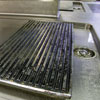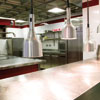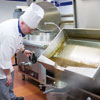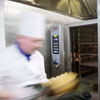My new kitchen: London's Caledonian Club
A complete overhaul of the kitchen, after an extension increased the size of the late-Victorian building by a third, has meant an upgrade of the whole food operation at London's Caledonian Club. Diane Lane reports
In his 18 years at the Caledonian Club in London, head chef Paul Hodson has worked from a basement kitchen with the food being sent up to the first-floor dining and two function rooms on two dumb waiters and, for almost two years while the building work took place, in temporary kitchens supplied by Dawson Rentals and housed in three Portacabins on the terrace.
His dream was to have a kitchen on the same level as the dining rooms and to see the food produced by his 12-strong brigade going out on a pass. "We had raised the standards as high as we could," he says. "Not having a pass made it difficult to control the standard."
Plans to change the style of banqueting in the Selkirk and Stuart function rooms from silver service to plated service and a desire to introduce fine dining in the 60-seat members' dining room were the influencing factors in the design of two new kitchens costing a total of £1m at the Belgravia mansion house, home of the private members' club since 1946.
Hodson and club secretary Paul Varney worked with Ian Clow, then of C&C Catering Equipment, and the company's managing director and chairman of the Catering Equipment Distributors Association, Peter Kitchin, to get the layout absolutely right. C&C was also on site during the kitchen's first day of operation - a grand opening of the new extension with a luncheon for 300 and a visit by the Queen - just in case of any teething problems.
Located on the first floor, the main kitchen is required to turn out about 70-80 covers a day over lunch and dinner, while the basement banqueting kitchen needs to provide 150-200 covers a day for functions in the enlarged banqueting facilities, including a music room seating 180 and a library that doubles as a reception room. A threefold increase in turnover for the department has been forecast for this year.
The club has between 13,000 and 14,000 members, with membership conditional on the individual being Scottish, of Scottish descent, a Scottish landowner or having served in the higher ranks of a Scottish regiment. Many are frequent visitors to the club for breakfast, lunch and dinner or resident in one of the 36 bedrooms, so the small menu changes every two weeks to provide variety. Traditional Scottish, modern British and classical French cuisine are all incorporated in both banqueting and members' dining menus, and the fine dining is going down a treat, with dishes such as pheasant and pistachio terrine with a red berry compote, and breasts of partridge with a steamed leek pudding, cocotte potatoes and a tarragon juice.
A traditional red Charvet suite measuring 3,500mm x 1,600mm forms the heart of the main kitchen on the first floor adjacent to the two main function rooms. Having seen planchas in action in France, Hodson was sold on the idea and had one incorporated on either side of the suite.
Each side also has a 900mm x 450mm cast-iron solid-top rated at 12kW with heat-conducting fins underneath and an offset bull's-eye. On one side is an open burner rated at 10kW and supplied with a removable wok. It has a water bath underneath that acts as a cool zone for spillage to prevent it drying out and sticking. The sauce section has a chargrill for fillet steaks and Dover sole, both of which are popular with members.
At one end is a salamander, which is kept on pilot during service and reaches temperature almost instantly when needed for finishing. It's also used by the waiting staff to make melba toast.
Underneath the salamander is an integral temperature-held stainless-steel bain-marie designed to cut out at 98°C and used for sauces and breakfast porridge. Around the bain-marie the suite's 3mm-thick top of stainless steel with titanium provides plenty of space for plating up right next to the pass.
There's an oven on each side, and additional features include taps for filling pots and pans with water without the need to carry them from the sink. Two fryers used for chips, goujons and deep-fried parsley are placed back-to-back at the far end of the suite, although they weren't incorporated within it because they won't have the same longevity.
There's a steamer for the inevitable large volume of haggis, sourced from George Cockburn & Son in Dingwall, Ross-shire, and served with neeps, as tradition demands. An existing Convotherm combi-oven has been kept on in the new kitchen and is used for tasks such as baking soufflés. A ventilated ceiling covers the entire kitchen.
Refrigeration here is by Gram and consists of one three-door and two four-door under-counter cabinets and one upright freezer chosen for its energy-saving features and three-year warranty. The larder section has a Williams saladette bar for holding garnishes, plus a Gram ice-cream freezer.
What was once the main kitchen in the basement is now a dedicated banqueting kitchen. Some existing kit has been retained, including two Falcon solid-top ranges, a Falcon chargrill, a stockpot burner and a Bartlett convection oven, which regularly turns out 200 Yorkshire puddings. New items include a 150-litre boiling pan and 120-litre bratt pan by Charvet. A Vent Master ventilation canopy with built-in lighting keeps things cool around the cooking line.
A 30-grid Rational combi-oven is presently used for roasting but will be the key to the new plated banqueting when it really gets going, and delivery of an additional 60-grid model is eagerly anticipated. Plating will be done in a room adjacent to the banqueting kitchen, which is used for butchery and fish prep.
There are two Foster coldrooms in the basement area, one exclusively for meat. The pastry area is in a larder just off the basement kitchen and has a dumb waiter to transport desserts to the first floor.
One of the planchas incorporates a ribbed element used by the breakfast chef for bacon and sausages. Hodson hadn't previously used planchas but was impressed when he saw them in use on a visit to France with Charvet. "They're used for everything," he says, "from 120 scallops seared as they're called away to medallions of beef, veal and rösti potatoes." They consist of a 20mm-thick steel base plate with a chrome coating of 70 microns thickness and are gas rated at 15kW with the temperature thermostatically controlled between 80°C and 310°C. A grease-collection channel runs around each plancha.
After 18 years Hodson finally has a pass, complete with four rise-and-fall lights, so he can check all dishes as they leave for the members' dining room and so have control over the standard of the food. Fine dining is now available each evening, alongside the traditional club favourites.
Contacts
- The Caledonian Club 020 7333 8722
- Catering Equipment Distributors Association 01274 826056
- C&C Catering Equipment 01244 375012
- Charvet 01342 717936
- Convotherm (Enodis UK) 0845 370 4888
- Dawson Rentals 01600 716851
- Electrolux Professional 0121-220 2800
- Falcon Foodservice Equipment 01786 455200
- Foster Refrigerator 01553 691122
- Gram UK 01322 616900
- Rational 01582 480388
- Vent Master 01634 666111
- Williams Refrigeration 01553 817000









